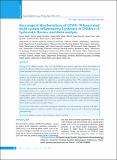Please use this identifier to cite or link to this item:
https://hdl.handle.net/20.500.14356/1027Full metadata record
| DC Field | Value | Language |
|---|---|---|
| dc.contributor.author | Nepal, Gaurav | - |
| dc.contributor.author | Shrestha, Gentle Sunder | - |
| dc.contributor.author | Rehrig, Jessica Holly | - |
| dc.contributor.author | Gajurel, Bikram Prasad | - |
| dc.contributor.author | Ojha, Rajeev | - |
| dc.contributor.author | Agrawal, Aditi | - |
| dc.contributor.author | Panthi, Sandesh | - |
| dc.contributor.author | Khatri, Bharat | - |
| dc.contributor.author | Adhikari, Ishan | - |
| dc.date.accessioned | 2023-04-20T06:45:54Z | - |
| dc.date.available | 2023-04-20T06:45:54Z | - |
| dc.date.issued | 2021 | - |
| dc.identifier.citation | NepalG., ShresthaG. S., RehrigJ. H., GajurelB. P., OjhaR., AgrawalA., PanthiS., KhatriB., & AdhikariI. (2021). Neurological Manifestations of COVID-19 Associated Multi-system Inflammatory Syndrome in Children: A Systematic Review and Meta-analysis. Journal of Nepal Health Research Council, 19(1), 10-18. https://doi.org/10.33314/jnhrc.v19i1.3410 | en_US |
| dc.identifier.issn | Print ISSN: 1727-5482; Online ISSN: 1999-6217 | - |
| dc.identifier.uri | http://103.69.126.140:8080/handle/20.500.14356/1027 | - |
| dc.description | Review Article | en_US |
| dc.description.abstract | Abstract Background: Children comprise only 1–5% of COVID-19 cases. Recent studies have shown that COVID-19 associated multisystem inflammatory syndrome in children (MIS-C) can present with neurological signs and symptoms. In this systematic review and meta-analysis, we have reviewed neurological involvement in these patients. Methods: A comprehensive electronic literature search was done on PubMed, Google Scholar, Embase, Cochrane database, and SCOPUS for the published English language articles from December 1, 2019, to February 28, 2021. A meta-analysis of the proportion was expressed as a pooled proportion with a 95% confidence interval (CI). Representative forest plots showing individual studies and the combined effect size were generated to provide an overview of the results. Results: This systematic review and meta-analysis analyzed 15 published MIS-C studies with a total of 785 patients. Neurological manifestations in patients with MIS-C was found in 27.1%. We found that 27% developed headaches, 17.1% developed meningism/meningitis and 7.6 % developed encephalopathy. Other uncommon neurological manifestations of MIS-C includes anosmia, seizures, cerebellar ataxia, global proximal muscle weakness and bulbar palsy. In MIS-C patients with neurological feature, neuroimaging showed signal changes in the splenium of the corpus callosum. Electroencephalography showed slow wave pattern and nerve conduction studies and electromyography showed mild myopathic and neuropathic changes. Conclusions: Our study revealed that neurological manifestations are not uncommon in patients with MIS-C. Further large prospective studies are needed to better explore the disease spectrum and to unravel the underlying pathophysiology. Keywords: Children; COVID-19; kawasaki disease; MIS-C, neurology | en_US |
| dc.language.iso | en | en_US |
| dc.publisher | Nepal Health Research Council | en_US |
| dc.relation.ispartofseries | Jan-March, 2021;3410 | - |
| dc.subject | Children | en_US |
| dc.subject | COVID-19 | en_US |
| dc.subject | Kawasaki disease | en_US |
| dc.subject | MIS-C, neurology | en_US |
| dc.title | Neurological Manifestations of COVID-19 Associated Multi-system Inflammatory Syndrome in Children: A Systematic Review and Meta-analysis | en_US |
| dc.type | Journal Article | en_US |
| local.journal.category | Review Article | - |
| Appears in Collections: | Vol. 19 No. 1 (2021): Vol. 19 No. 1 Issue 50 Jan-Mar 2021 | |
Files in This Item:
| File | Description | Size | Format | |
|---|---|---|---|---|
| 3410-Manuscript-21540-1-10-20210425.pdf | 777.42 kB | Adobe PDF |  View/Open |
Items in DSpace are protected by copyright, with all rights reserved, unless otherwise indicated.
